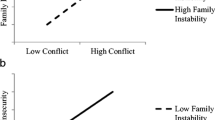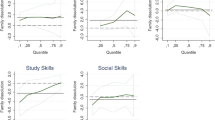This study examines the relation between family instability and child maladjustment over a 6-year period in 369 children from four communities. Measures were collected annually from kindergarten through fifth grade. In associative growth curve models, family instability trajectories predicted children's externalizing and internalizing behavior trajectories during this time period. High levels of family instability also incrementally predicted the likelihood of meeting criteria for a DSM IV diagnosis during elementary school, above and beyond prediction from earlier measures of maladjustment. However, the timing of family instability had a different effect on externalizing versus internalizing disorders. In general, stronger relations were found between family instability and externalizing behaviors relative to internalizing behaviors, although children with comorbid disorders experienced the highest levels of family instability.



Similar content being viewed by others
REFERENCES
Adrian, C., & Hammen, C. (1993). Stress exposure and stress generation in children of depressed mothers. Journal of Consulting and Clinical Psychology, 6, 354–359.
Achenbach, T. M. (1991). Integrative guide for the 1991 CBCL, YSR, and TRF profiles. Burlington: University of Vermont.
Ackerman, B., Brown, E., D’Eramo, K., & Izard, C. (2002). Maternal relationship instability and the school behavior of children from disadvantaged families. Developmental Psychology, 38, 694–704.
Ackerman, B., Kogos, J., Youngstrom, E., Schoof, K., & Izard, C. (1999). Family instability and the problem behaviors of children from economically disadvantaged families. Developmental Psychology, 35, 258–268.
Angold, A., Costello, E. J., & Erkanli, A. (1999). Comorbidity. Journal of Child Psychology and Psychiatry, 40, 57–87.
Bennett, K., Lipman, E., Brown, S., Racine, Y., Boyle, M., & Offord, D. (1999). Predicting conduct problems: Can high-risk children be identified in kindergarten and grade 1? Journal of Consulting and Clinical Psychology, 67, 470–480.
Berden, F., Althaus, M., & Velhulst, F. (1990). Major life events and change in behavioral functioning of children. Journal of Child Psychology and Psychiatry, 31, 949–959.
Buckner, J., & Bassuk, E. (1997). Mental disorders and service utilization among youths from homeless and low-income housed families. Journal of the American Academy of Child and Adolescent Psychiatry, 36, 890–900.
Campbell, S., Pierce, E., Moore, G., Marakovitz, S., & Newby, K. (1996). Boys' externalizing problems at elementary school age: Pathways from early behavior problems, maternal control, and family stress. Development and Psychopathology, 8, 701–719.
Capaldi, D., & Patterson, G. (1991). Relation of parental transition to boy's adjustment problems: I. A linear hypothesis. II. Mothers at risk for transitions and unskilled parenting. Developmental Psychology, 27, 489–504.
Chorpita, B., & Barlow, D. (1998). The role of control in the early environment. Psychological Bulletin, 124, 3–21.
Compas, B., Howell, D., Phares, V., Williams, R., & Giunta, C. (1989). Risk factors for emotional/behavioral problems in young adolescents: A prospective analysis of adolescent and parental stress and symptoms. Journal of Consulting and Clinical Psychology, 57, 732–740.
Conduct Problems Prevention Research Group (1992). A developmental and clinical model for the prevention of conduct disorder: The Fast Track Program. Development and Psychopathology, 4, 509–527.
Costello, E., Edelbrock, C., & Costello, A. (1985). Validity of the NIMH Diagnostic Interview Schedule for Children: A comparison between psychiatric and pediatric referrals. Journal of Abnormal Child Psychology, 13, 579–595.
Cummings, E. M., & Davies, P. (1996). Emotional security as a regulatory process in normal development and the development of psychopathology. Development and Psychopathology, 8, 123–139.
Dubois, D., Felner, R., Meares, H., & Krier, M. (1994). Prospective investigation of the effects of socioeconomic disadvantage, life stress, and social support on early adolescent adjustment. Journal of Abnormal Psychology, 103, 511–522.
Eckenrode, J., Rowe, E., Laird, M., & Braithwaite, J. (1995). Mobility as a mediator of the effects of child maltreatment on academic performance. Child Development, 66, 1130–1142.
Egeland, B., & Kreutzer, T. (1991). A longitudinal study of the effects of maternal stress and protective factors on the development of high-risk children. In E. M. Cummings, A. Greene, and K. Karraker (Eds.), Life-span developmental psychology: Perspectives on stress and coping (pp. 61–84). Hillside, NJ: Lawrence Erlbaum Associates.
Elder, G., Nguyen, T., & Caspi, A. (1985). Linking family hardship to children's lives. Child Development, 56, 361–375.
Ge, X., Lorenz, F., Conger, R., Elder, G., & Simons, R. (1994). Trajectories of stressful life events and depressive symptoms during adolescence. Developmental Psychology, 30, 467–483.
Greenberg, M., Lengua, L., Coie, J., Pinderhughes, E., & the Conduct Problems Prevention Research Group (1999). Predicting developmental outcomes at school entry using a multiple-risk model: Four American communities. Developmental Psychology, 35, 403–417.
Guerra, N., Huesmann, R., Tolan, P., Van Acker, R., & Eron, L. (1995). Stressful events and individual beliefs as correlates of economic disadvantage and aggression among urban children. Journal of Consulting and Clinical Psychology, 63, 518–528.
Hetherington, E. M., Bridges, M., & Insabella, G. (1998). What matters? What does not? Five perspectives on the association between marital transitions and children's adjustment. American Psychologist, 53, 167–184.
Lochman, J., & Conduct Problems Prevention Research Group (1995). Screening of child behavior problems for prevention programs at school entry. Journal of Consulting and Clinical Psychology, 63, 549–559.
Mathijssen, J., Koot, H., & Verhulst, F. (1999). Predicting change in problem behavior from child and family characteristics and stress in referred children and adolescents. Development and Psychopathology, 11, 305–320.
McLoyd, V., Jayaratne, T., Ceballo, R., & Borquez, J. (1994). Unemployment and work interruption among African American single mothers: Effect on parenting and adolescent socioemotional functioning. Child Development, 65, 562–589.
Milan, S. (2002). Trajectories of family instability and individual adjustment during middle childhood. Unpublished doctoral dissertation, Vanderbilt University, Tennessee.
Milan, S., & Pinderhughes, E. (2000). Factors influencing maltreated children's adjustment to foster care. Development and Psychopathology, 12, 63–81.
Nolen-Hoeksema, S., Girgus, J., & Seligman, M. (1992). Predictors and consequences of childhood depressive symptoms: A 5-year longitudinal study. Journal of Abnormal Psychology, 101, 405–422.
Shaffer, D., Fisher, P., Dulcan, M., & Davis, M. (1996). Diagnostic Interview Schedule for Children Version 2.3: Description, acceptability, prevalence rates, and performance in the MECA study. Journal of the American Academy of Child and Adolescent Psychiatry, 35, 865–877.
Tennant, C. (1988). Parental loss in childhood: Its effect in adult life. Archives of General Psychiatry, 45, 1045–1050.
Weiss, B., Suesser, K., & Catron, T. (1998). Common and specific features of childhood psychopathology. Journal of Abnormal Psychology, 107, 118–127.
Willett, J., Singer, J., & Martin, N. (1998). The design and analysis of longitudinal studies of developmental and psychopathology in context: Statistical models and methodological recommendations. Development and Psychopathology, 10, 395–426.
Wothke, W. (2000). Longitudinal and multigroup modeling with missing data. In T. Little & K. Schnaebel (Eds.), Modeling multilevel and longitudinal data: Practical issues, applied approaches, and specific examples (pp. 219–240). Mahwah, NJ: Lawrence Erlbaum Associates, Inc.
Zahn-Waxler, C., Klimes-Dougan, B., & Slattery, M. (2000). Internalizing problems of childhood and adolescence: Prospects, pitfalls, and progress in understanding the develo`pment of anxiety and depression. Development and Psychopathology, 12, 443–454.
ACKNOWLEDGMENTS
This paper is based on part of the first author's dissertation. The Fast Track project has been supported by NIMH Grants RI8 MH 48043, RI8 MH 50951, RI8 MH 50952, and R18 MH 50953. The Center for Substance Abuse Prevention also has provided support for Fast Track through a memorandum of agreement with the NIMH. This work was also supported in part by Department of Education Grant S 184U30002 and NIMH Grants K05 MH 0079.
Author information
Authors and Affiliations
Consortia
Corresponding author
Additional information
The Conduct Problems Prevention Research group is comprised of Karen L. Bierman (Pennsylvania State University), John D. Coie (Duke University), Kenneth A. Dodge (Duke University), E. Michael Foster (Pennsylvania State University), Mark Greenberg (Pennsylvania State University), John E. Lochman (University of Alabama), Robert J. McMahon (University of Washington), and Ellen E. Pinderhughes (Tufts University)
Rights and permissions
About this article
Cite this article
Milan, S., Pinderhughes, E.E. & The Conduct Problems Prevention Research Group. Family Instability and Child Maladjustment Trajectories During Elementary School. J Abnorm Child Psychol 34, 40–53 (2006). https://doi.org/10.1007/s10802-005-9007-6
Published:
Issue Date:
DOI: https://doi.org/10.1007/s10802-005-9007-6




